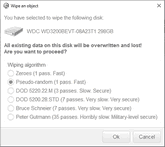


- Contents
- Index
- R-Drive Image
- Disk Actions
- Advanced File Filtering
- RAIDs, and Various Disk and Volume Managers
- Startup Version
- Scheduled Actions, Command Line Operations, and Scripting
-
Technical Information
- Updates
- Cloud Services
- FTP/FTPS Servers
- Network Drives
- Image Replications
- Logging
- Creating Consistent Point-in-Time Backups
- Support for Various Disk Partitioning Schemes and File Systems
- Supported Virtual Disk and Disk Image Formats
- Disk Wiping Algorithms
- Supported CD and DVD Recorders
- List of Hardware Devices Supported in the Startup Mode
- R-Drive Image OEM kit
© 2025 R-Tools Technology Inc.
All rights reserved.
Disk Wiping Algorithms
Data wiping is necessary only for files stored on conventional hard drives. Data stored on SSD storage devices cannot be effectively wiped out due to the principles of operation of these devices.
Currently R-Drive Image supports 5 wiping algorithms:
 Wiping algorithms
Wiping algorithms
|
Zeroes |
The disk is filled with zeroes through 1 pass. The fastest but the least secure algorithm. Also it does not conceal the fact that the disk or file has been wiped. |
|
Pseudo-random numbers |
The disk is filled with pseudo-random numbers through 1 pass. A slower but little bit more secure algorithm than the Zeroes algorithm and it also conceals to some degree the fact that the disk or file has been wiped. |
|
DoD 5220.22-M(3) |
The disk is wiped using Department of Defense standard 5220.22-M(3). Provides high-grade data wiping filling the unused space or file with a special digital pattern through 3 passes This algorithm is very secure, but slow. |
|
DoD 5200.28-STD(7) |
The disk is wiped using Department of Defense standard 5200.28-STD(7). Provides high-grade data wiping filling the unused space or file with a special digital pattern through 7 passes. This algorithm is very secure, but very slow. |
|
Bruce Schneier(7) |
The disk is wiped using the Bruce Schneier's algorithm . Provides high-grade data wiping filling the unused space or file with a special digital pattern through 7 passes. This algorithm is very secure, but very slow. |
|
Peter Gutmann (35) |
The disk is wiped using the Peter Gutmann's algorithm . Provides high-grade data wiping filling the unused space or file with a special digital pattern through 35 passes. This algorithm is military-level secure, but horribly slow. |
What algorithm is to choose, depends on your specific needs. All of these wiping algorithms make recovery of wiped data with any software-based data recover utility impossible. So if you want to protect your information from a casual snooper, you may safely choose either the Zeroes or Pseudo-random numbers algorithm. The latter also conceals the fact that you wiped the data.
If you want more security , you need to know the following:
There are some techniques for recovery of wiped data. These techniques are based on the fact that magnetic medium on the hard drive's platters "store" some information about previously written data. Such information cannot be completely removed. Wiped data may be recovered even from mechanically damaged platters. So the only safe way to completely remove data from a hard drive is to mechanically grind the magnetic medium off the drive platters or dissolve them in special chemical solvents.
But in order to recover the wiped data using one of these techniques, a hard drive must be disassembled, its platters placed in a precise magnetic field measurement system, and the results of such measurement statistically processed. All that is very expensive and requires a very qualified and experienced personnel and a specially developed equipment. Only a very advanced organization such as a law enforcement or intelligence agency of a developed nation, or a special high-tech firm can afford this. Moreover, each successive wiping pass makes such data recovery much and much harder. So, the DoD 5220.22-M(3) clearing and sanitizing standard overwriting the data with a special pattern through 3 passes is a rather reliable and safe choice for this case.
If you need the ultimate security, use the DoD 5220.22-M(7) clearing and sanitizing standard, or even the Peter Gutmann (35 ) wiping algorithm. They render data almost unrecoverable, but they are extremely slow.
- R-Studio Technician: activation using a USB stick
- Data Recovery Guide
- Why R-Studio?
- R-Studio for Forensic and Data Recovery Business
- R-STUDIO Review on TopTenReviews
- File Recovery Specifics for SSD devices
- How to recover data from NVMe devices
- Predicting Success of Common Data Recovery Cases
- Recovery of Overwritten Data
- Emergency File Recovery Using R-Studio Emergency
- RAID Recovery Presentation
- R-Studio: Data recovery from a non-functional computer
- File Recovery from a Computer that Won't Boot
- Clone Disks Before File Recovery
- HD Video Recovery from SD cards
- File Recovery from an Unbootable Mac Computer
- The best way to recover files from a Mac system disk
- Data Recovery from an Encrypted Linux Disk after a System Crash
- Data Recovery from Apple Disk Images (.DMG files)
- File Recovery after Re-installing Windows
- R-Studio: Data Recovery over Network
- How To Use R-Studio Corporate Package
- Data Recovery from a Re-Formatted NTFS Disk
- Data Recovery from an ReFS disk
- Data Recovery from a Re-Formatted exFAT/FAT Disk
- Data Recovery from an Erased HFS Disk
- Data Recovery from an Erased APFS Disk
- Data Recovery from a Re-Formatted Ext2/3/4FS Disk
- Data Recovery from an XFS Disk
- Data Recovery from a Simple NAS
- How to connect virtual RAID and LVM/LDM volumes to the operating system
- Specifics of File Recovery After a Quick Format
- Data Recovery After Partition Manager Crash
- File Recovery vs. File Repair
- Data Recovery from Virtual Machines
- How to Connect Disks to a Computer
- Emergency Data Recovery over Network
- Data Recovery over the Internet
- Creating a Custom Known File Type for R-Studio
- Finding RAID parameters
- Recovering Partitions on a Damaged Disk
- NAT and Firewall Traversal for Remote Data Recovery
- Data Recovery from an External Disk with a Damaged File System
- File Recovery Basics
- Default Parameters of Software Stripe Sets (RAID 0) in Mac OS X
- Data Recovery from Virtual Hard Disk (VHD/VHDX) Files
- Data Recovery from Various File Container Formats and Encrypted Disks
- Automatic RAID Parameter Detection
- IntelligentScan Data Recovery Technology
- Multi-pass imaging in R-Studio
- Runtime Imaging in R-Studio
- Linear Imaging vs Runtime Imaging vs Multi-Pass Imaging
- USB Stabilizer Tech for unstable USB devices
- Joint work of R-Studio and PC-3000 UDMA hardware
- Joint work of R-Studio and HDDSuperClone
- R-Studio T80+ - A Professional Data Recovery and Forensic Solution for Small Business and Individuals Just for 1 USD/day
- Backup Articles
- R-Drive Image Standalone and Corporate license transferring
- Fixing Windows update error 0x80070643 with R-Drive Image
- Backup with Confidence
- R-Drive Image as a free powerful partition manager
- Computer Recovery and System Restore
- Disk Cloning and Mass System Deployment
- Accessing Individual Files or Folders on a Backed Up Disk Image
- R-Drive Image startup / bootable version
- File Backup for Personal Computers and Laptops of Home and Self-Employed Users
- Creating a Data Consistent, Space Efficient Data Backup Plan for a Small Business Server
- How to Move the Already Installed Windows from an Old HDD to a New SSD Device and Create a Hybrid Data Storage System
- How to Move an Installed Windows to a Larger Disk
- How to Move a BitLocker-Encrypted System Disk to a New Storage Device
- How to backup and restore disks on Linux and Mac computers using R-Drive Image
- Undelete Articles
- Get Deleted Files Back
- Free Recovery from SD and Memory cards
- R-Undelete: Video Recovery
- Recovery from an External Device with a Damaged File System
- File recovery from a non-functional computer
- Free File Recovery from an Android Phone Memory Card
- Free Photo and Video File Recovery Tutorial
- Easy file recovery in three steps


